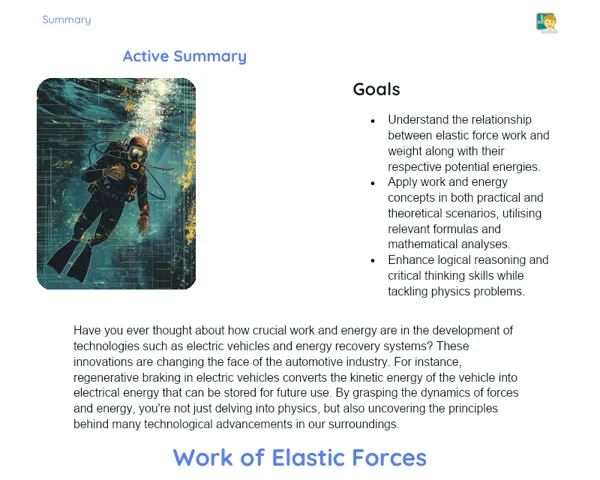Socioemotional Summary Conclusion
Goals
1. Grasp the concept of average angular velocity as the change in angular position over a given time.
2. Apply the principles of average angular velocity to everyday examples, like the motion of clock hands or a vehicle making a turn.
Contextualization
Ever wondered how clock hands always know when to move? Or how a car executes a turn so smoothly? 🎯 These circular motions we observe in our daily lives serve as practical examples of average angular velocity! Let's explore together how this concept influences our everyday experiences and learn how to calculate it! 🚗💨🕰️
Exercising Your Knowledge
Definition of Average Angular Velocity
Average angular velocity measures how quickly an object changes its angular position in circular motion over time. In simple terms, it shows us how much an object has rotated over a specific time frame. For instance, if a ceiling fan completes one full rotation in one second, that's its average angular velocity.
-
Formula: Average angular velocity (ωm) is defined using the formula ωm = Δθ / Δt, where Δθ represents the change in angular position in radians, and Δt is the time interval in seconds.
-
Units: Typically, angular position is expressed in radians (rad) and time in seconds (s), hence average angular velocity is measured in radians per second (rad/s).
-
Importance: A solid understanding of average angular velocity is crucial for solving physics problems related to circular motion, as well as for practical purposes, such as regulating the rotational speed of various machines.
Units of Measurement
Familiarity with the units of measurement used to calculate average angular velocity is essential for making accurate calculations and effective scientific communication. Angular position is normally measured in radians (rad), which is dependent on the arc length of a circle. Time, however, is measured in seconds (s).
-
Radians (rad): A radian refers to the measure of an angle that corresponds to an arc whose length equals the radius of the circle. It is the standard unit in the International System (SI) for measuring angles.
-
Seconds (s): This denotes the unit of time in the International System (SI), critical for establishing the speed of angular change.
-
Conversions: In various practical cases, it may be necessary to convert degrees to radians or vice versa, as radians are the preferred unit for scientific evaluations.
Practical Everyday Examples
Average angular velocity is observable in numerous daily situations, contributing to our understanding and prediction of movements. These examples help visualize the concept and its relevant applications.
-
Clock Hands: A quintessential example of circular motion, where the angular position of the clock hands changes continuously over time.
-
Car Making a Turn: When driving, the speed at which a car negotiates a turn can be assessed through average angular velocity, facilitating safer driving choices.
-
Fans: The blades of a ceiling fan rotate at a consistent average angular velocity, and knowing this speed can enhance maintenance and energy efficiency.
Key Terms
-
Average Angular Velocity: Rate of change of angular position with time.
-
Radians (rad): Unit of angular measurement derived from the arc length of a circle.
-
Seconds (s): Measurement of time in the International System (SI).
For Reflection
-
How can insights into average angular velocity empower you to make safer decisions in daily activities, particularly when driving?
-
What feelings did you experience during the lesson while calculating average angular velocity? How did you manage those emotions?
-
In what ways can you leverage the concept of average angular velocity to enhance an activity or hobby involving circular motions?
Important Conclusions
-
Understanding average angular velocity enables us to compute the rate of change of an object's angular position in circular motion over time.
-
The units of measurement for average angular velocity are vital for ensuring precise calculations and facilitating scientific discussions.
-
Real-life examples such as fans, cars turning, and clock hands showcase the relevance of this concept.
-
Being able to compute average angular velocity aids us in making informed and responsible choices, like adjusting the rotational speed of machinery.
Impacts on Society
Grasping the concept of average angular velocity significantly influences various aspects of our lives. For instance, while driving, understanding this concept allows drivers to modify their speed during turns, enhancing road safety. This not only helps in avoiding accidents but also alleviates stress and anxiety when driving under challenging conditions. Furthermore, knowledge of average angular velocity is beneficial in maintaining household appliances like fans and washing machines, optimizing their efficiency and contributing to energy savings, which benefits both the household budget and the environment.
Moreover, the analysis of average angular velocity is pivotal in numerous professions, including engineering, physics, and even healthcare, where imaging equipment like CT scanners rely on this principle for proper function. By deepening their comprehension of this knowledge, students can not only boost their academic skills but also nurture important capabilities that apply to both their careers and daily life. This fosters a sense of responsibility and emotional management, essential for academic and personal achievement.
Dealing with Emotions
To effectively manage your emotions while studying average angular velocity, I recommend a straightforward exercise based on the RULER approach. First, take a moment to reflect on how you feel during your studies. Are you feeling puzzled, curious, or a bit overwhelmed? Determine what’s triggering these emotions – is it the complexity of the topic or looming deadlines? Identify and jot down your emotions. Next, express these feelings appropriately, whether by having a conversation with a classmate or taking a breather to recharge. Finally, consider how you can regulate these emotions to prevent them from hindering your learning. Perhaps listening to some soothing music or going for a quick stroll could help.
Study Tips
-
Create visual summaries: Utilize diagrams and charts to illustrate circular motion and the average angular velocity formula. This enhances visualization and comprehension.
-
Engage with real examples: Experiment by calculating the average angular velocity of objects around you, like ceiling fans or bicycles. This renders studying more interactive and relevant.
-
Collaborate in groups: Discussing concepts and solving problems as a team can help clarify any uncertainties while creating a collaborative and less stressful learning atmosphere.



